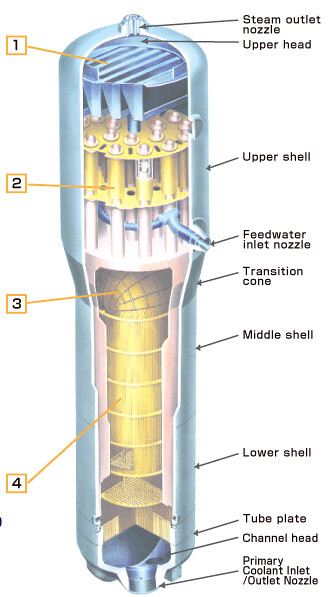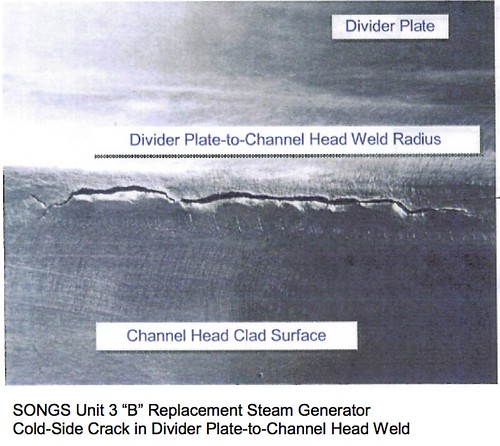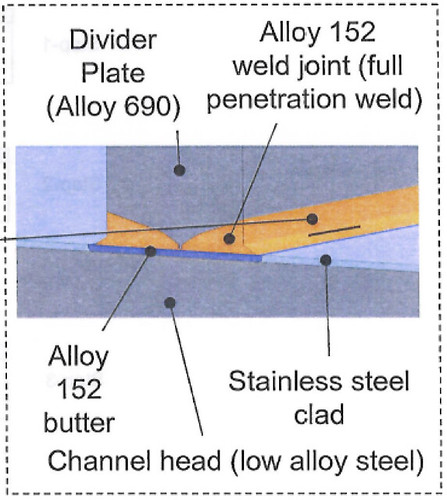
That's a diagram of Mitsubishi Heavy Industry's PWR and APSR steam generator, with the pieces-parts labeled. In case anyone missed my diary of last night, San Onofre: "Unprecedented" Steam Generator Tube Failure, Unit 3 of the San Clemente nuke had to shut down on Tuesday of this week because a leak in one (or both) of its RSGs [Replacement Steam Generators, installed in January of 2011] set off radiation alarms in the auxiliary building. Inspection of Unit 2's RSGs was conducted yesterday because that plant is down for outage, and "unusual" tube wear was discovered in more than 800 of the more than 9,500 tubes that carry superheated, pressurized reactor coolant water [~600ºF] into the SGs to heat secondary feedwater to steam to turn the turbines and generate electricity. Unit 2's RSGs were also manufactured by Mitsubishi Heavy Industries and were installed in the fall of 2009.
Here is a link to a DOE report from their Energy Information Administration/Electric Power Monthly, published in August of 1995 which explains in some detail the function of Steam Generators in a PWR nuclear power plant, and what can go wrong with SGs. Which along with the reactor itself are the most expensive components of a nuclear generating plant. It's worth a read just to get the general overview of why these non-reactor components are so important.
Steam Generator Degredation and Its Impact on Continued Operation of Pressurized Water Reactors in the United States [pdf]
Apparently there was a little manufacturing problem with SONGS' Unit 3 RSGs, that everyone involved knew about at the time. Here is the NRC's Information Notice to license holders on that very issue, from April of 2010 -
NRC: Welding Defects in Replacement Steam Generators [pdf]
On March 18, 2009, MHI conducted a routine visual inspection after completion of the American Society of Mechanical Engineers Boiler and Pressure Vessel Code (ASME Code), Section III primary and secondary side hydrostatic pressure test on the SONGS Unit 3 "B" RSG and discovered a 5-inch long surface flaw (crack) in the dissimilar metal weld between the divider plate, made from Alloy 690, and the channel head, made from low-alloy steel (LAS). The flaw formed between the LAS and the Alloy 152 butter. A photograph of flaw and a schematic diagram of the weld joint are shown…
Here's a photograph from that NRC Notice that shows the 5-inch long crack:

Look back at the Mitsubishi component diagram atop this diary. You will see that the divider plate and channel head are at the bottom of the SG. Hot, pressurized reactor coolant water enters the SG from the bottom through one channel of the head, and is forced into the tubes that begin in the divider plate. The cooler, lower pressure secondary feedwater flows around and in between those tubes to heat to boiling, the steam exits out the top while the primary coolant goes back out the head through the other channel to be routed back to the reactor.
Here's a diagram of the juncture weld that got so messed up, with the crack drawn on the through-weld to the right…

SGE and Mitsubishi tried to fix the problem by one method, but that didn't work. So they had to try again with different method, and that apparently worked good enough for NRC approval. The issue (unsuitable surface preparation method) with the Unit 3 RSGs was not present when the Unit 2 RSGs were manufactured, so the current problem with Unit 2's steam generators is something else.
We have not seen a report on any specific tube leak or 'unusual' wear for Unit 3, so a leak between the primary inlet and the tube inlets or outlets could be their culprit. Remember the significant pressure and temperature differential at work between the primary and feedwater systems in these generators, separated solely by the metal in the tube walls.
For your perusing pleasure, here's the Press Release from MHI from February of 2009 announcing delivery of SONGS Unit 2's RSGs, the ones with all the 'unusual' tube wear:
MHI Completes Delivery of 2 Replacement Steam Generators to California's Largest Electric Utility [pdf]
The RSGs delivered are among the world's largest, each measuring approximately seven meters (22 feet) in external diameter, weighing 580 metric tons and housing approximately 10,000 heat transfer tubes. The RSGs arrived at the SONGS site on February 14 and are slated to replace existing steam generators (SGs) at SONGS Unit 2 during its next refueling and maintenance outage scheduled in autumn 2009. Later this year, MHI will ship two additional RSGs to SCE for installation in SONGS Unit 3 during the fall of 2010.
MHI received the RSGs order from SCE in September of 2004 after winning an international bidding competition. The RSGs were manufactured at the company's Kobe Shipyard & Machinery Works.
Wow. 'Won' an international bidding competition for Cheapest Replacement Steam Generators! The many ways specs could have been fudged a little bit here or there to ensure adequate corporate profit are plentiful.
San Onofre probably won't be running much longer given the great expense for these RSGs [~$1.3 billion for 4 RSGs], even at the cut-rate lowest bid on the planet. Because they'll need to be replaced again, and I doubt the people of Southern California are going to want to pay extra to cover the cost. Again. Which is fine, since there really doesn't need to be any nuclear accidents-waiting-to-happen on the earthquake prone California coast.
So anyway, this serves as the technical follow-up to yesterday's diary for those paying attention and seeking information about what, exactly, the problem is at San Onofre.


